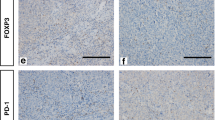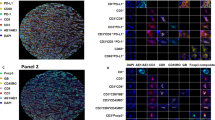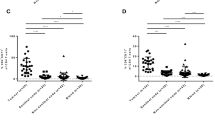Abstract
In this study, 40 biopsy samples collected from cervical cancer patients at the First Affiliated Hospital of Xi'an Jiaotong University, China, were retrospectively assessed using immunohistochemistry for CD4+ and CD8+ tumor-infiltrating lymphocytes (TILs) and were analyzed for the expression of FOXP3, OX40, granzyme B (GrB) and perforin (Prf). The proliferating index of the TILs was determined by assessing Ki67 expression. We determined the prognostic value of low and high numbers of TILs on survival by performing Kaplan–Meier analysis using median values as the cut-off points. Except for the number of CD4+FOXP3+ regulatory T cells (Tregs) and the CD4/CD8 ratio, none of the CD4+, CD8+, OX40+, GrB+ or Prf+ TILs were associated with the overall 5-year survival rate. The 5-year survival rate was significantly lower in patients who had a high percentage of Tregs as compared with the those who had a lower percentage (35.3% versus 88.9%, P=0.001), while the 5-year survival rate was significantly higher in patients with a high CD4/CD8 ratio as compared with patients who had a low CD4/CD8 ratio (82.4% versus 44.4%, P=0.029). When we considered the deaths and surviving cases as separate groups, we found that both the number of CD4+ T cells and the CD4/CD8 ratio were significantly lower in patients who died as compared with those who survived (26.33±11.80 versus 47.79±38.18, P=0.023 and 0.60±0.25 versus 1.17±1.02, P=0.019, respectively). In conclusion, decreased proportions of tumor-infiltrating CD4+ T cells with high percentages of Tregs and reversed CD4/CD8 ratios were significantly associated with the clinical outcome of patients with cervical carcinoma.
This is a preview of subscription content, access via your institution
Access options
Subscribe to this journal
Receive 12 digital issues and online access to articles
$119.00 per year
only $9.92 per issue
Buy this article
- Purchase on Springer Link
- Instant access to full article PDF
Prices may be subject to local taxes which are calculated during checkout






Similar content being viewed by others
References
Umansky V, Schirrmacher V, Rocha M . New insights into tumor-host interactions in lymphoma metastasis. J Mol Med 1996; 74: 353–363.
Disis ML, Bernhard H, Jaffee EM . Use of tumour-responsive T cells as cancer treatment. Lancet 2009; 373: 673–683.
Ruffini E, Asioli S, Filosso PL, Lyberis P, Bruna MC et al. Clinical significance of tumor-infiltrating lymphocytes in lung neoplasms. Ann Thorac Surg 2009; 87: 365–371.
Leffers N, Gooden MJ, de Jong RA, Hoogeboom BN, ten Hoor KA, Hollema H et al. Prognostic significance of tumor-infiltrating T-lymphocytes in primary and metastatic lesions of advanced stage ovarian cancer. Cancer Immunol Immunother 2009; 58: 449–459.
Tomsova M, Melichar B, Sedlakova I, Steiner I . Prognostic significance of CD3+ tumor infiltrating lymphocytes in ovarian carcinoma. Gynecol Oncol 2008; 108: 415–420.
Dunn GP, Dunn IF, Curry WT . Focus on TILs: prognostic significance of tumor infiltrating lymphocytes in human glioma. Cancer Immun. 2007; 7: 12.
Couzin J . Cancer. T cells a boon for colon cancer prognosis. Science 2006; 313: 1868–1869.
Sato E, Olson SH, Ahn J, Bundy B, Nishikawa H, Qian F et al. Intraepithelial CD8+ tumor infiltrating lymphocytes and a high CD8+/regulatory T cell ratio are associated with favorable prognosis in ovarian cancer. Proc Natl Acad Sci USA 2005; 102: 18538–18543.
Prall F, Duhrkop T, Weirich V, Ostwald C, Lenz P, Nizze H et al. Prognostic role of CD8+ tumor-infiltrating lymphocytes in stage III colorectal cancer with and without microsatellite instability. Hum Pathol 2004; 35: 808–816.
Fukunaga A, Miyamoto M, Cho Y, Murakami S, Kawarada Y, Oshikiri T et al. CD8+ tumor-infiltrating lymphocytes together with CD4+ tumor-infiltrating lymphocytes and dendritic cells improve the prognosis of patients with pancreatic adenocarcinoma. Pancreas 2004; 28: 26–31.
Pardoll DM, Topalian SL . The role of CD4+ T cell responses in antitumor immunity. Curr Opin Immunol 1998; 10: 588–594.
Toes RE, Ossendorp F, Offringa R, Melief CJ . CD4 T cells and their role in antitumor immune responses. J Exp Med 1999; 189: 753–756.
Ho WY, Yee C, Greenberg PD . Adoptive therapy with CD8+ T cells: it may get by with a little help from its friends. J Clin Invest 2002; 110: 1415–1417.
Bevan MJ . Helping the CD8+ T-cell response. Nat Rev Immunol 2004; 4: 595–602.
Dudley ME, Wunderlich JR, Robbins PF, Yang JC, Hwu P, Schwartzentruber DJ et al. Cancer regression and autoimmunity in patients after clonal repopulation with antitumor lymphocytes. Science 2002; 19: 850–854.
Sobhani I, Le Gouvello S . Critical role for CD8+FoxP3+ regulatory T cells in colon cancer immune response in humans. Gut 2009; 58: 743–744.
Salama P, Phillips M, Grieu F, Morris M, Zeps N, Joseph D et al. Tumor-infiltrating FOXP3+ T regulatory cells show strong prognostic significance in colorectal cancer. J Clin Oncol 2009; 27: 186–192.
Gjerdrum LM, Woetmann A, Odum N, Burton CM, Rossen K, Skovgaard GL et al. FOXP3+ regulatory T cells in cutaneous T-cell lymphomas: association with disease stage and survival. Leukemia 2007; 21: 2512–2518.
Fu J, Xu D, Liu Z, Shi M, Zhao P, Fu B et al. Increased regulatory T cells correlate with CD8 T-cell impairment and poor survival in hepatocellular carcinoma patients. Gastroenterology 2007; 132: 2328–2339.
Yu P, Fu YX . Tumor-infiltrating T lymphocytes: friends or foes? Lab Invest 2006; 86: 231–245.
Sasaki A, Tanaka F, Mimori K, Inoue H, Kai S, Shibata K et al. Prognostic value of tumor-infiltrating FOXP3+ regulatory T cells in patients with hepatocellular carcinoma. Eur J Surg Oncol 2008; 34: 173–179.
Yoshioka T, Miyamoto M, Cho Y, Ishikawa K, Tsuchikawa T, Kadoya M et al. Infiltrating regulatory T cell numbers is not a factor to predict patient's survival in oesophageal squamous cell carcinoma. Br J Cancer 2008; 98: 1258–1263.
Lee NR, Song EK, Jang KY, Choi HN, Moon WS, Kwon K et al. Prognostic impact of tumor infiltrating FOXP3 positive regulatory T cells in diffuse large B-cell lymphoma at diagnosis. Leuk Lymphoma 2008; 49: 247–256.
Grabenbauer GG, Lahmer G, Distel L, Niedobitek G . Tumor-infiltrating cytotoxic T cells but not regulatory T cells predict outcome in anal squamous cell carcinoma. Clin Cancer Res 2006; 12: 3355–3360.
Yan W, Le Z, Hongyan W, Juxiang X, Lusheng S, Yili W . The ex vivo microenvironments in MLTC of poorly immunogenic tumor cells facilitate polarization of CD4+CD25+ regulatory T cells. Cell Mol Immunol 2006; 3: 123–129.
Patel S, Chiplunkar S . Host immune responses to cervical cancer. Curr Opin Obstet Gyneco 2009; 21: 54–59.
Loddenkemper C, Hoffmann C, Stanke J, Nagorsen D, Baron U, Olek S et al. Regulatory (FOXP3+) T cells as target for immune therapy of cervical intraepithelial neoplasia and cervical cancer. Cancer Sci 2009; 100: 1112–1117.
Bosch FX, Manos MM, Munoz N, Sherman M, Jansen AM et al. Prevalence of human papillomavirus in cervical cancer: a worldwide perspective. International biological study on cervical cancer (IBSCC) Study Group. J Natl Cancer Inst 1995; 87: 796–802.
Munoz N, Bosch FX, de Sanjose S, Herrero R, Castellsagué X, Shah KV et al. Epidemiologic classification of human papillomavirus types associated with cervical cancer. N Engl J Med 2003; 348: 518–527.
Shah W, Hongwei C, Jin Z, Lifang D, Jun Y, Yili W . The prevalence of human papillomavirus type 58 in Chinese patients with cervical carcinoma and its influence on survival. Clin Oncol (R Coll Radiol). 2009; 21: 768–774.
Piersma SJ, Jordanova ES, van Poelgeest MI, Kwappenberg KM, van der Hulst JM, Drijfhout JW et al. High Number of Intraepithelial CD8+ tumor-infiltrating lymphocytes is associated with the absence of lymph node metastases in patients with large early-stage cervical cancer. Cancer Res 2007; 67: 354–361.
Kondratiev S, Sabo E, Yakirevich E, Lavie O, Resnick MB . Resnick. Intratumoral CD8+ T lymphocytes as a prognostic factor of survival in endometrial carcinoma. Clin Cancer Res 2004; 10: 4450–4456.
Chiba T, Ohtani H, Mizoi T, Naito Y, Sato E, Nagura H et al. Intraepithelial CD8+ T-cell-count becomes a prognostic factor after a longer follow-up period in human colorectal carcinoma: possible association with suppression of micrometastasis. Br J Cancer 2004; 91: 1711–1717.
Schumacher K, Haensch W, Roefzaad C, Schlag PM . Prognostic significance of activated CD8+ T cell infiltrations within esophageal carcinomas. Cancer Res 2001; 61: 3932–3936.
Sharma P, Shen Y, Wen S, Yamada S, Jungbluth AA, Gnjatic S et al. CD8 tumor-infiltrating lymphocytes are predictive of survival in muscle-invasive urothelial carcinoma. Proc Natl Acad Sci USA 2007; 104: 3967–3972.
Wakabayashi O, Yamazaki K, Oizumi S, Hommura F, Kinoshita I, Ogura S et al. CD4+ T cells in cancer stroma, not CD8+ T cells in cancer cell nests, are associated with favorable prognosis in human non-small cell lung cancers. Cancer Sci 2003; 94: 1003–1009.
Nakano O, Sato M, Naito Y, Suzuki K, Orikasa S, Aizawa M et al. Proliferative activity of intratumoral CD8+ T-lymphocytes as a prognostic factor in human renal cell carcinoma: clinicopathologic demonstration of antitumor immunity. Cancer Res 2001; 61: 5132–5136.
Monnier-Benoit S, Mauny F, Riethmuller D, Guerrini JS, Căpîlna M, Félix S et al. Immunohistochemical analysis of CD4+ and CD8+ T-cell subsets in high risk human papillomavirus-associated pre-malignant and malignant lesions of the uterine cervix. Gynecol Oncol 2006; 102: 22–31.
Santin AD, Bellone S, Palmieri M, Bossini B, Roman JJ, Cannon MJ et al. Induction of tumor-specific cytotoxicity in tumor infiltrating lymphocytes by HPV16 and HPV18 E7-pulsed autologous dendritic cells in patients with cancer of the uterine cervix. Gynecol Oncol 2003; 89: 271–280.
Baniyash M . TCR ζ-chain down regulation: curtailing an excessive inflammatory immune response. Nat Rev Immunol 2004; 4: 675–687.
Wang HY, He JJ, Shi QF, Lai BC, Ding HY, Zheng J et al. Clinicopathological significance of cytotoxic lymphocytes in breast cancer and draining lymph nodes. Zhonghua Bing Li Xue Za Zhi. 2009; 38: 384–388. Chinese.
Nedergaard BS, Ladekarl M, Thomsen HF, Nyengaard JR, Nielsen K . Low density of CD3+, CD4+ and CD8+ cells is associated with increased risk of relapse in squamous cell cervical cancer. Br J Cancer 2007; 97: 1135–1138.
Badoual C, Hans S, Rodriguez J, Peyrard S, Klein C, Agueznay Nel H et al. Prognostic value of tumor-infiltrating CD4+ T-cell subpopulations in head and neck cancers. Clin Cancer Res 2006; 12: 465–472.
Sakaguchi S . Naturally arising CD4+ regulatory T cells for immunologic self-tolerance and negative control of immune responses. Annu Rev Immunol 2004; 22: 531–562.
Baecher-Allan C, Viglietta V, Hafler DA . Human CD4+CD25+ regulatory T cells. Semin Immunol 2004; 16: 89–98.
Onizuka S, Tawara I, Shimizu J, Sakaguchi S, Fujita T, Nakayama E . Tumor rejection by in vivo administration of anti-CD25 (interleukin-2 receptor) monoclonal antibody. Cancer Res 1999; 59: 3128–3133
Shimizu J, Yamazaki S, Sakaguchi S . Induction of tumor immunityby removing CD25+CD4+ T cells: a common basis between tumor immunity and autoimmunity. J Immunol 1999; 163: 5211–5218.
Nishikawa H, Kato T, Tawara I, Takemitsu T, Saito K, Wang L et al. Accelerated chemically induced tumor development mediated by CD4+CD25+ regulatory T cells in wild-type hosts. Proc Natl Acad Sci USA 2005; 102: 9253–9257.
Sutmuller RP, van Duivenvoorde LM, van Elsas A, Schumacher TN, Wildenberg ME, Allison JP et al. Synergism of cytotoxic T lymphocyte-associated antigen 4 blockade and depletion of CD25+ regulatory T cells in antitumor therapy reveals alternative pathways for suppression of autoreactive cytotoxic T lymphocyte responses. J Exp Med 2001; 194: 823–832.
Tanaka H, Tanaka J, Kjaergaard J, Shu S . Depletion of CD4+CD25+ regulatory cells augments the generation of specific immune T cells in tumor-draining lymph nodes. J Immunother 2002; 25: 207–217.
van der Burg SH, Piersma SJ, de Jong A, van der Hulst JM, Kwappenberg KM, van den Hende M et al. Association of cervical cancer with the presence of CD4+ regulatory T cells specific for human papillomavirus antigens. Proc Natl Acad Sci USA 2007; 104: 12087–12092.
Sheu BC, Hsu SM, Ho HN, Lin RH, Torng PL, Huang SC . Reversed CD4/CD8 ratios of tumor-infiltrating lymphocytes are correlated with the progression of human cervical carcinoma. Cancer 1999; 86: 1537–1543.
Chen L, Linsley PS, Hellström KE . Costimulation of T cells for tumor immunity. Immunol Today 1993; 14: 483–486.
Cheng TY, Wu JT, Lin RH . Induction of tumor-specific T cell response by cognating tumor cells with foreign antigen-primed Th cells. Int Immunol 1998; 10: 1397–1406.
Greenberg PD . Adoptive T cells therapy of tumors: mechanisms operative in the recognition and elimination of tumor cells. Adv Immunol 1991; 49: 281–355.
Baskar S, Glimcher L, Nabavi N, Jones RT, Ostrand-Rosenberg S . Major histocompatibility complex II1B7211 tumor cells are potent vaccines for stimulating tumor rejection on tumor-bearing mice. J Exp Med 1995; 181: 619–629.
Unitt E, Marshall A, Gelson W, Rushbrook SM, Davies S, Vowler S et al. Tumour lymphocytic infiltrate and recurrence of hepatocellular carcinoma following liver transplantation. J Hepatol 2006; 45: 246–253.
Acknowledgements
The authors thank the Department of Radiation Oncology of the First Affiliated Hospital of the Medical College of Xi'an Jiaotong University for providing tissue samples and clinical data. This study was supported by the Higher Education Commission of Pakistan and the Foundation of Bureau of Health (Grant No. 04D13) of Shaanxi Province, China.
Author information
Authors and Affiliations
Corresponding authors
Rights and permissions
About this article
Cite this article
Shah, W., Yan, X., Jing, L. et al. A reversed CD4/CD8 ratio of tumor-infiltrating lymphocytes and a high percentage of CD4+FOXP3+ regulatory T cells are significantly associated with clinical outcome in squamous cell carcinoma of the cervix. Cell Mol Immunol 8, 59–66 (2011). https://doi.org/10.1038/cmi.2010.56
Received:
Revised:
Accepted:
Published:
Issue Date:
DOI: https://doi.org/10.1038/cmi.2010.56
Keywords
This article is cited by
-
Soluble lymphocyte activation gene-3 (sLAG3) and CD4/CD8 ratio dynamics as predictive biomarkers in patients undergoing immune checkpoint blockade for solid malignancies
British Journal of Cancer (2024)
-
Towards a better preclinical cancer model – human immune aging in humanized mice
Immunity & Ageing (2023)
-
Recent advances and future challenges of tumor vaccination therapy for recurrent glioblastoma
Cell Communication and Signaling (2023)
-
Peripheral blood lymphocytes differentiation patterns in responses / outcomes to immune checkpoint blockade therapies in non-small cell lung cancer: a retrospective study
BMC Cancer (2023)
-
Immunotherapies landscape and associated inhibitors for the treatment of cervical cancer
Medical Oncology (2023)



